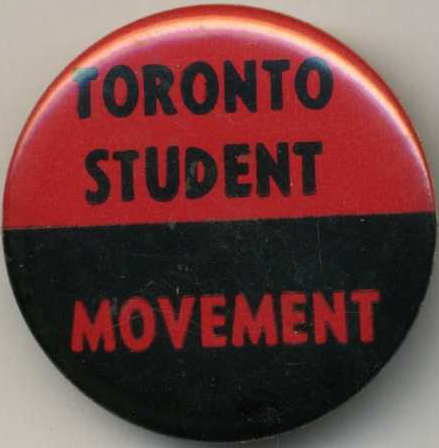
Information to change the world | |
Find Topics, Titles, Names related to your query |

Information to change the world | |
Find Topics, Titles, Names related to your query |
|
|
Toronto Student Movement (TSM)The Toronto Student Movement was organized at the University of Toronto in the summer of 1968. Its founding coincided with student revolts in Quebec, France, Germany, Italy, and the U.S. While there were many issues (such as the Vietnam War) galvanizing student uprisings, the primary focus of the TSM was education itself. The university was seen as itself oppressive and intent on re-creating subservience to capitalist and imperialist projects. An important event which brought radical students together at the University of Toronto was the 1967 demonstration and sit-in targeting DOW Chemical’s recruiting on the University of Toronto campus. DOW manufactured napalm, an incendiary chemical widely used by the U.S. military in its war against Vietnam; by allowing DOW to recruit on campus, the university was seen to be complicit in war crimes. Students involved in the action came to see the need for an ongoing organization to challenge the university. The TSM aimed to change both the university’s power-structure and much of the course content. For example, the TSM set up counter-seminars that challenged the reactionary content of U of T political science classes. TSM also created study groups on issues such as health care, Marxism, and feminism that were housed at Rochdale College – a “free university” and residence located on the U of T campus. TSM also attempted to establish a radical student base outside the student council, while exposing the corporate connections of the U of T’s Board of Governors and Chancellor. TSM activists became fascinated by the “student as nigger” concept advocated by American activist Jerry Farber, who used the trope to reveal the subservient position of all students. This concept led to some very confrontational demonstrations and actions on campus. In late November of 1968, TSM enlarged its action by coming out in support of a strike being waged by members of the Newspaper Guild against the Peterborough Examiner – a newspaper that had recently been acquired by the wealthy Thomson chain of newspapers. TSM students felt that the elite Thomson family owners cared nothing about community issues, or a community focus for the newspaper. Nonetheless, the members of the Newspaper Guild were more focused on job security, and the attempt to forge a working relationship between TSM and striking journalists was not very productive. In February of 1969, TSM took a more aggressive strategy, after having created a free speech area in the social science building and held numerous rallies on campus. The Royal Ontario Museum had invited Clark Kerr, the former President of the University of California, to give an address to some 500 invited guests. Kerr had been president during the Berkeley free speech fight of 1964. Subsequently, he had become a counter-insurgency expert specializing in industrial relations and student control. As TSM saw it, Kerr had been invited to Toronto to spread the word on how to dismantle radical student power and uprisings. During the middle of Clark Kerr’s address, about 100 students stormed onto the stage, removed the microphone from Kerr’s grasp, and demanded that he go home. It was a turning point for TSM, which more than doubled its membership in the following week as the U of T campus became more politicized. At the same time, political tensions were developing in the TSM between those who broadly identified with the “new left” and those who were attracted to the Maoist ideology promoted by the American PL formation and its Canadian counterpart, the Canadian Party of Labour (CPL). In the summer of 1969, the Toronto Student Movement split, with some joining CPL’s Worker-Student Alliance, while most reformed into the New Left Caucus. Related Reading: Related Topics: 
|
Connect with Connexions



|